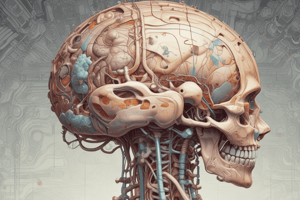Podcast
Questions and Answers
What is the shape of the falx cerebri?
What is the shape of the falx cerebri?
- Crescent-shaped (correct)
- Circular-shaped
- Sickle-shaped
- Triangular-shaped
What runs along the attachment of the tentorium cerebelli to the falx cerebri?
What runs along the attachment of the tentorium cerebelli to the falx cerebri?
- Inferior sagittal sinus
- Superior sagittal sinus
- Straight sinus (correct)
- Transverse sinus
What is the function of the tentorium cerebelli?
What is the function of the tentorium cerebelli?
- It forms the walls of the posterior cranial fossa and supports the parietal lobes
- It supports the frontal lobes of the cerebral hemisphere
- It forms the roof of the posterior cranial fossa and supports the occipital lobes (correct)
- It forms the floor of the posterior cranial fossa and supports the temporal lobes
What is the attachment site of the falx cerebri?
What is the attachment site of the falx cerebri?
What is the shape of the falx cerebelli?
What is the shape of the falx cerebelli?
What runs along the attachment of the tentorium cerebelli to the petrous bone?
What runs along the attachment of the tentorium cerebelli to the petrous bone?
What is the function of the tentorial notch?
What is the function of the tentorial notch?
What is the attachment site of the falx cerebelli?
What is the attachment site of the falx cerebelli?
What is the primary function of the meninges?
What is the primary function of the meninges?
Which layer of dura mater lines the inner surface of bones?
Which layer of dura mater lines the inner surface of bones?
What is the function of the dural venous sinuses?
What is the function of the dural venous sinuses?
How many septa are sent inward by the meningeal layer?
How many septa are sent inward by the meningeal layer?
What is the name of the septum that lies in the midline between the two cerebral hemispheres?
What is the name of the septum that lies in the midline between the two cerebral hemispheres?
What is the function of the septa sent inward by the meningeal layer?
What is the function of the septa sent inward by the meningeal layer?
What is the name of the sinus located in the Falx cerebri?
What is the name of the sinus located in the Falx cerebri?
Where does the endosteal layer of the dura mater of the cranium meet the endosteal layer of the dura mater of the spinal cord?
Where does the endosteal layer of the dura mater of the cranium meet the endosteal layer of the dura mater of the spinal cord?
What is the function of arachnoid granulations?
What is the function of arachnoid granulations?
What is the location of subdural hemorrhage?
What is the location of subdural hemorrhage?
What is the characteristic of subarachnoid hemorrhage?
What is the characteristic of subarachnoid hemorrhage?
What is the function of the subarachnoid space?
What is the function of the subarachnoid space?
What is the location of the superior cistern?
What is the location of the superior cistern?
What is the characteristic of epidural hemorrhage?
What is the characteristic of epidural hemorrhage?
What is the function of the arachnoid mater?
What is the function of the arachnoid mater?
What is the name of the cistern that lies around the brainstem?
What is the name of the cistern that lies around the brainstem?
Where is the posterior fixed margin of the diaphragma sellae located?
Where is the posterior fixed margin of the diaphragma sellae located?
What is the function of the small opening in the center of the diaphragma sellae?
What is the function of the small opening in the center of the diaphragma sellae?
Which nerve branch is responsible for the innervation of the dura in the anterior cranial fossa?
Which nerve branch is responsible for the innervation of the dura in the anterior cranial fossa?
What is the consequence of stimulation of sensory endings of the trigeminal nerve above the level of the tentorium cerebelli?
What is the consequence of stimulation of sensory endings of the trigeminal nerve above the level of the tentorium cerebelli?
Which artery provides the most significant blood supply to the dura?
Which artery provides the most significant blood supply to the dura?
Which vein drains the blood from the middle meningeal artery?
Which vein drains the blood from the middle meningeal artery?
What is the consequence of stimulation of sensory endings of the trigeminal nerve below the level of the tentorium cerebelli?
What is the consequence of stimulation of sensory endings of the trigeminal nerve below the level of the tentorium cerebelli?
What is the location of the dura that is innervated by the first three cervical nerves and the vagus nerve?
What is the location of the dura that is innervated by the first three cervical nerves and the vagus nerve?
Flashcards are hidden until you start studying
Study Notes
Meninges
- Definition: Three protective membranes surrounding the brain and spinal cord in the skull and vertebral column
- Functions: Mechanical protection of brain and spinal cord, protection of cerebral and spinal blood vessels, and pathway for cerebrospinal fluid (CSF)
Dura Mater
- Consists of two layers: endosteal layer and meningeal layer
- Endosteal layer lines the inner surface of bones, while meningeal layer is a dense, strong, fibrous membrane covering the brain
- Dural venous sinuses are located between the two layers, responsible for venous drainage of the cranium
- Meningeal layer sends inward four septa, dividing the cranial cavity and lodging subdivisions of the brain, restricting rotatory displacement
Septa of Dura Mater
- Four septa: Falx Cerebri, Falx Cerebelli, Tentorium Cerebelli, and Diaphragma Sellae
- Functions: restrict rotatory displacement of brain, divide cranial cavity, and lodge subdivisions of brain
Falx Cerebri
- Shape: sickle-shaped fold of dura mater
- Location: lies in the midline between two cerebral hemispheres
- Two ends: anterior end attached to internal frontal crest and crista galli, posterior end blends with tentorium cerebelli
- Base: upper fixed margin attached to skull, where superior sagittal sinus runs
- Inferior sagittal sinus runs in its lower free margin, and straight sinus runs along its attachment to tentorium cerebelli
Tentorium Cerebelli
- Shape: crescent-shaped fold of dura mater
- Location: forms the roof of the posterior cranial fossa, covering the cerebellum and supporting the occipital lobes of the cerebral hemispheres
- Attached to falx cerebri and falx cerebelli, with an inner free border and an outer fixed border
- Tentorial notch: gap in front, allowing passage of the midbrain
- Sinuses attach to tentorium cerebelli: straight sinus, superior petrosal sinus, and transverse sinus
Falx Cerebelli
- Shape: small, sickle-shaped fold of dura mater
- Location: attached to internal occipital crest, projects forward between two cerebellar hemispheres
- Posterior fixed margin contains the occipital sinus
Diaphragma Sellae
- Shape: small, circular fold of dura mater
- Location: forms the roof of the sella turcica
- Small opening in its center allows passage of the stalk of the pituitary gland
Dural Nerve Supply
- Innervation:
- Anterior cranial fossa: anterior and posterior ethmoidal nerves (ophthalmic division of trigeminal nerve)
- Middle cranial fossa: recurrent meningeal branch, meningeal branch of maxillary division, and meningeal branch of mandibular division (all trigeminal nerve)
- Posterior cranial fossa: above tentorium cerebelli, recurrent meningeal branch (ophthalmic division of trigeminal nerve); below tentorium cerebelli, first three cervical nerves and vagus nerve
- Trigeminal nerve stimulation produces referred pain: headache above level of tentorium cerebelli, neck stiffness below level of tentorium cerebelli
Dural Blood Supply
- Small branches: internal carotid and maxillary arteries
- Middle meningeal artery is of greater significance
- Veins: middle meningeal vein follows branches of middle meningeal artery and drains into maxillary vein
Arachnoid Mater
- Delicate, impermeable membrane covering the brain and lying between dura mater and pia mater
- Subdural space: potential space between arachnoid and dura mater
- Subarachnoid space: potential space between arachnoid and pia mater, filled with CSF
- Arachnoid granulations: small projections into superior sagittal venous sinus
- Subarachnoid cisterns: areas where arachnoid and pia are widely separated, e.g., chiasmatic, interpeduncular, pontine, cerebellomedullary, and superior cisterns
Studying That Suits You
Use AI to generate personalized quizzes and flashcards to suit your learning preferences.




